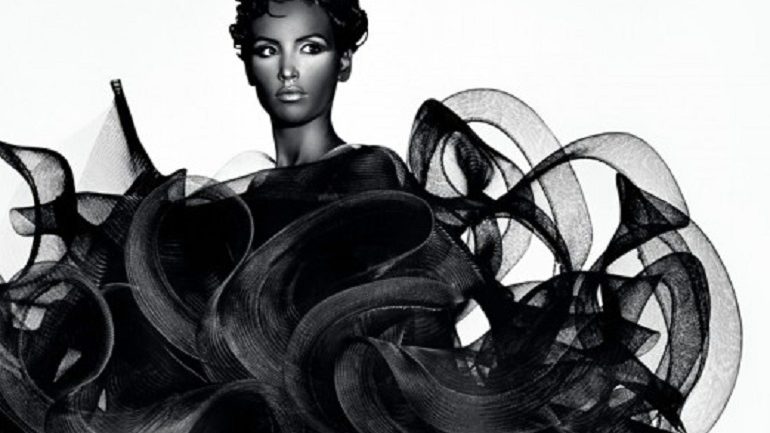FASHION & STYLE
Autumn/Winter 1993 by Koji Tatsuno one of the Japanese Fashion Designers. Photo: Masayuki Hayashi. Image courtesy of PEM
FASHION & STYLE
BY KAZAD
Japanese fashion designers such as Issey Miyake, Rei Kawakubo and, Yohji Yamamoto are breaking norms with their radical approach to fashion by using art to create avant-garde designs
SALEM, MA –When it comes to fashion, Japan is cool. For more than two decades, Japan has forcefully inserted itself into the fashion world, forcing a rethinking of fashion design. Presently at the Peabody Essex Museum (PEM) is an exhibition celebrating the ingenuity and innovation of contemporary Japanese fashion designers.
Future Beauty: Avant-Garde Japanese Fashion features nearly 100 dresses, skirts, gowns, and suits, and other items of clothing from renowned Japanese Fashion designers. The show was originally co-organized by the Kyoto Costume Institute and Barbican Art Gallery, London, It provides an insight into how Japanese designers have reshaped the idea of fashion and fashion design.
At the center of the show are three distinguished Japanese designers: Issey Miyake, Rei Kawakubo, and Yohji Yamamoto. With their designs, they challenge conventional ideas to give prominence to new forms of fashion movement. Miyake, Kawakubo, and Yamamoto are audacious in their exploration of innovative forms, techniques, and materials. They often cross the threshold of fashion into art with their designs.
Alternate Definitions of Beauty
“The fashion designers featured in this exhibition are remarkable for their daring visions, bold wit, and incisive creativity,” said Lynda Roscoe Hartigan, PEM’s James B. and Mary Lou Hawkes Chief Curator and the exhibition’s coordinating curator. “Through their designs, we are exposed to alternate definitions of beauty, new ways of considering the human form, and insight into some of the most provocative artistic minds working today,” she added
The Japanese fashion designers in this show have made a great impact in the fashion world because of their radical approach to design. Instead of following the Western convention of fashion design, they created a new language of fashion that combines the cute with the absorbed. There is a play on texture, variability, imperfection, and looseness of layered fabric.
For many of these Japanese designers, fashion should be seen as an effort to resolve the tension between flatness and form: The activation of a piece of fabric into two dimensional and three-dimensional forms must be the fundamental principle of fashion design. In Hiroaki Ohya’s The Wizard of Jeanz collection, for instance, this principle of transforming a flat fabric into a two-dimensional garment and three-dimensional experiences is cleverly explored. Composed as a series of books, Ohya’s works open out like enormous paper lanterns into a range of voluminous garments such as skirts and capes.
The popularity of Japanese fashion began in1983 when Japanese designers thrilled the fashion world during the Paris Catwalk. At the event, Rei Kawakubo and Yohji Yamamoto introduced their black and white collections that left many awestruck. Science then, Japanese fashion designers have not wavered in their effort to dominate world fashion culture.
Perfection is Ugly
Japanese fashion design deviates from the Western concept of fashion which gives credence to sexual forms, balance, and perfection. Japanese fashion designers find imperfection, mistakes and accidents, asymmetry, roughness simplicity as an integral part of fashion design. So, instead of faultlessness, Japanese designers celebrate imperfection. As designer Yohji Yamamoto puts it, “I think perfection is ugly.”
Kawakubo and Yamamoto’s designs were considered radical by critics at the Paris Catwalk. However, many people loved their work and they have become part of the world’s fashion vocabulary. Across Western metropolises, their designs are on the streets of New York and Paris. Similarly, in Japan, their designs define anything cute. Cute combined with a reinterpretation of gothic, punk, hip-hop, and strange has helped Japan create a hybrid fashion culture that continually fluctuates the luminal space.
Japanese Fashion Design
At the heart of Japanese fashion design is material. The development of synthetic and industrial fabrics in Japan after the Second World War opened up new opportunities for designers. After the war, the Japanese realized that they could create an amazing array of textures, visual effects using new techniques of weaving and dying. It soon became clear to many designers that fabric presented endless possibilities. An example of that endless possibility is evident in Junya Watanabe’s voluminous honeycomb construction in his Autumn/Winter 2000-01 Techno Couture collection. It exemplifies this ultra-modern approach to fashion that unlocked the potential of using fabric as a sculptural material.
LIFESTYLE| READ ALSO: Fashion Designer Jean Paul Gaultier Shows in Australia
Japanese fashion designers are making an impact in the fashion world because their designs challenge the conventional approach to fashion design. The creativeness inherent in Japanese fashion culture has given it global recognition and appeal. A sense of high fashion pervades the streets of Japan today because of the innovative works of the designers in this show and many others.
In the space of 20 years, Tokyo’s Shibuya and Harajuku have become the major centers of the fashion world, especially when it comes to youth fashion. Many of the youth fashion is mimetic of animation and cartoon characters are now part of the fashion lexicon. Lolita, Cosplay, manga such as Hello Kitty and Astro Boy have become integral to Japan’s fashion vocabulary. Today, anyone looking for innovation in fashion design must first look at Japan.
Japanese Fashion Designers

Hiroaki Ohya for Ohya, Spring/Summer 2000. Collection of the Kyoto Costume Institute. Photo: Masayuki Hayashi. Image courtesy of PEM

Junya Watanabe, Autumn/Winter 2000 Collection of the Kyoto Costume Institute. Photo: Takashi Hatakeyama


